Analysis of the Spatial Distribution of New Cases of Leprosy in the State of Pernambuco, Northeast Brazil
Abstract
1. Introduction
2. Materials and Methods
2.1. Area of Study
2.2. Study Design
2.3. Period of Reference and Study Population
- (a)
- Inclusion criteria: All new cases (individuals who have never received any specific treatment for the disease), new cases in children under the age of 15, new cases with grade 2 disability at the time of diagnosis, residents of Pernambuco, with a year of diagnosis within the study period;
- (b)
- Exclusion criteria: All cases with a diagnostic error outcome.
2.4. Data Source
2.5. Definition of Indicators
2.6. Data Analysis
3. Results
3.1. Spatial Analysis of General Incidence
3.2. Spatial Analysis of Incidence in Children Under 15 Years of Age
3.3. Spatial Analysis of the Incidence of Grade 2 Disability at Diagnosis
4. Discussion
5. Conclusions
Supplementary Materials
Author Contributions
Funding
Institutional Review Board Statement
Informed Consent Statement
Data Availability Statement
Acknowledgments
Conflicts of Interest
References
- Duck, M. Let them talk and we listen: What are diseases of neglected people? Int. Health 2024, 16, i5–i6. [Google Scholar] [CrossRef]
- Van Wijk, R.; van Selm, L.; Barbosa, M.C.; van Brakel, W.H.; Waltz, M.; Puchner, K.P. Psychosocial burden of neglected tropical diseases in Eastern Colombia: An explorative qualitative study in persons affected by leprosy, cutaneous leishmaniasis and Chagas disease. Glob. Ment. Health 2021, 8, e21. [Google Scholar] [CrossRef] [PubMed]
- Qian, M.B.; Chen, J.; Bergquist, R.; Li, Z.J.; Li, S.Z.; Xiao, N.; Utzinger, J.; Zhou, X.N. Neglected tropical diseases in the People’s Republic of China: Progress towards elimination. Infect. Dis. Poverty 2019, 8, 86. [Google Scholar] [CrossRef] [PubMed]
- Maymone, M.B.C.; Laughter, M.; Venkatesh, S.; Dacso, M.M.; Rao, P.N.; Stryjewska, B.M.; Hugh, J.; Dellavalle, R.P.; Dunnick, C.A. Leprosy: Clinical aspects and diagnostic techniques. J. Am. Acad. Dermatol. 2020, 83, 1–14. [Google Scholar] [CrossRef] [PubMed]
- Santos, A.R.; Ignotti, E. Prevenção de incapacidade física por hanseníase no Brasil: Análise histórica. Cienc. Saude Coletiva 2020, 25, 3731–3744. [Google Scholar] [CrossRef]
- Neves, K.V.R.N.; Nobre, M.L.; Machado, L.M.G.; Steinmann, P.; Ignotti, E. Misdiagnosis of leprosy in Brazil in the period 2003–2017: Spatial pattern and associated factors. Acta Trop. 2021, 215, 105791. [Google Scholar] [CrossRef]
- Bueno, I.d.C.; Lages, D.D.S.; Lana, F.C.F. Spatial analysis of the epidemiological risk of leprosy in the municipalities of Minas Gerais. PLoS Negl. Trop. Dis. 2023, 17, e0011381. [Google Scholar] [CrossRef]
- World Health Organization. Leprosy Data Portal. Available online: https://apps.who.int/neglected_diseases/ntddata/leprosy/leprosy.html (accessed on 20 March 2024).
- Ferreira, G.R.O.N.; Miranda, A.L.C.; Farias, V.A.; Martins, M.B.; Neri, D.T.; Borges, W.D.; Cunha, C.L.F.; Dias, G.A.R.; Santos, D.C.; Sousa, F.J.D. Leprosy and tuberculosis control scenario of the National Program for the Improvement of Access and Quality of Primary Care in Brazil. BMC Health Serv. Res. 2023, 23, 825. [Google Scholar] [CrossRef]
- Silva, L.; Rocha, T.; Figueiredo Filho, D. The Global Leprosy Assessment Index (GLAI): A new approach for measuring the severity of disease in Brazil. Infect. Med. 2023, 2, 128–135. [Google Scholar] [CrossRef]
- da Rocha, A.M.; de Souza, E.A.; Ferreira, A.F.; Ferreira, N.N.L.; dos Reis, A.d.S.; de Andrade, A.R.; Silva, R.d.A.; Schoenmakers, A.; Ramos, A.N., Jr.; da Silva, J.A.M. The impact of COVID-19 on persons affected by leprosy and leprosy control in the North and Northeast of Brazil. Lepr. Rev. 2024, 95, 97–112. [Google Scholar] [CrossRef]
- Ministry of Health. National Strategy for Combating Leprosy 2024–2030; Ministry of Health: Brasília, Brazil, 2024; ISBN 978-65-5993-565-9. Available online: https://www.gov.br/saude/pt-br/centrais-de-conteudo/publicacoes/svsa/hanseniase/estrategia-nacional-para-enfrentamento-a-hanseniase-2024-2030/view (accessed on 11 June 2024).
- Leite, T.R.C.; Lopes, M.D.S.V.; Maia, E.R.; Cavalcante, E.G.R. Avaliação da estrutura da Atenção Primária à Saúde na atenção à hanseníase. Enferm. Foco 2019, 10, 73–78. [Google Scholar] [CrossRef]
- Trindade, L.C.; Martins, L.C.; Marques, D.M.; Mendes, M.d.S.; Fonseca, F.L.A.; Pereira, L.A.A. Importance of epidemiological surveillance of leprosy: Analysis of the occurrence of leprosy in intra-domiciliary contacts in a capital in the Brazilian Northeast region. Rev. Soc. Bras. Med. Trop. 2020, 53, e20190507. [Google Scholar] [CrossRef] [PubMed]
- de Sousa, G.S.; da Silva, R.L.F.; Xavier, M.B. Hanseníase e atenção primária à saúde: Uma avaliação de estrutura do programa. Saúde Debate 2017, 41, 230–242. [Google Scholar] [CrossRef]
- Li, X.; Jin, G.; Yang, J.; Li, Y.; Wei, P.; Zhang, L. Epidemiological characteristics of leprosy during the period 2005–2020: A retrospective study based on the Chinese surveillance system. Front. Public Health 2023, 10, 991828. [Google Scholar] [CrossRef]
- de Oliveira, R.A.; de Sousa, P.M.P.; da Silva, J.C.; Santos, L.F.S.; Santos, F.S.; Pascoal, L.M.; Costa, A.C.P.d.J.; dos Santos, L.H.; Santos Neto, M. Leprosy prevalence spatial distribution and trend in a health region in Northeast Brazil, 2008–2017: An ecological study. Epidemiol. Serv. Saúde 2023, 32, e2023522. [Google Scholar] [CrossRef]
- Barros, I.d.C.A.; Sousa, C.d.C.M.; da Silva, N.R.F.; Mascarenhas, M.D.M. Characterization of cases and epidemiological and operational indicators of leprosy: Analysis of time series and spatial distribution, Piauí State, Brazil, 2007–2021. Epidemiol. Serv. Saúde 2024, 33, e2023090. [Google Scholar] [CrossRef]
- Paz, W.S.; Ramos, R.E.S.; Bezerra, L.P.; Matos, D.F.; Tavares, D.S.; Souza, C.D.F.; Bezerra-Santos, M.; Ximenes, R.A.A. Temporal trend, high-risk spatial and spatiotemporal clustering of leprosy indicators in Brazil: A 20-year ecological and population-based study. Trop. Med. Int. Health 2023, 28, 517–529. [Google Scholar] [CrossRef]
- Boigny, R.N.; de Sousa Cavalcante, K.K.; Florencio, C.M.G.D.; Nogueira, P.S.F.; Gomes, C.M.; Alencar, C.H. Temporal trends and space-time distribution of leprosy relapse in Brazil from 2001 to 2021. Trans. R. Soc. Trop. Med. Hyg. 2024, 118, 537–549. [Google Scholar] [CrossRef]
- da Silva, M.L.F.I.; de Farias, S.J.M.; Silva, A.P.d.S.C.; Rodrigues, M.O.S.; de Oliveira, E.C.A. Spatial Patterns of New Leprosy Cases in a Northeastern State of Brazil, 2011–2021. Rev. Bras. Epidemiol. 2023, 26, e230014. [Google Scholar] [CrossRef]
- Ministry of Health. Epidemiological Bulletin of Leprosy—Special Issue, January 2025; Ministry of Health: Brasília, Brazil, 2025. Available online: https://www.gov.br/saude/pt-br/centrais-de-conteudo/publicacoes/boletins/epidemiologicos/especiais/2025/boletim-epidemiologico-de-hanseniase-numero-especial-jan-2025.pdf/view (accessed on 8 November 2025).
- Barbosa, C.C.; do Bonfim, C.V.; de Brito, C.M.G.; Ferreira, A.T.; Gregório, V.R.d.N.; de Oliveira, A.L.S.; Portugal, J.L.; de Medeiros, Z.M. Spatial analysis of reported new cases and local risk of leprosy in hyper-endemic situation in Northeastern Brazil. Trop. Med. Int. Health 2018, 23, 748–757. [Google Scholar] [CrossRef]
- Gonçalves, A.F.L.d.S.; de Lima, S.S.; Silva, A.P.d.S.C.; Barbosa, C.C. Spatial dynamics and socioeconomic factors correlated with American cutaneous leishmaniasis in Pernambuco, Brazil from 2008 to 2017. Rev. Soc. Bras. Med. Trop. 2020, 53, e20190373. [Google Scholar] [CrossRef]
- Barbosa, C.C.; do Bonfim, C.V.; de Brito, C.M.G.; de Souza, W.V.; Melo, M.F.d.O.; de Medeiros, Z.M. Spatial analysis of epidemiological and quality indicators of health services for leprosy in hyperendemic areas in Northeastern Brazil. Rev. Inst. Med. Trop. São Paulo 2020, 62, e93. [Google Scholar] [CrossRef] [PubMed]
- Brazilian Institute of Geography and Statistics (IBGE). Cities and States: Pernambuco. Available online: https://www.ibge.gov.br/cidades-e-estados/pe.html (accessed on 11 June 2024).
- Pernambuco State Department of Health. Regionalization Master Plan 2011; Pernambuco State Department of Health: Recife, Brazil, 2011. Available online: https://portal-antigo.saude.pe.gov.br/documentos/secretaria-executiva-de-coordenacao-geral/plano-diretor-de-regionalizacao-2011 (accessed on 11 June 2024).
- Parente, A.S.; de Santana, A.S.R.; Oliveira, S.R.d.A. Desempenho dos serviços de saúde do SUS de uma macrorregião do estado de Pernambuco, Brazil. Saúde Debate 2021, 45, 300–314. [Google Scholar] [CrossRef]
- Santos Parente, A.; Mesquita, F.O.S.; Sarmento, S. Análise da distribuição e cobertura do NASF na IV macrorregião de saúde do estado de Pernambuco. ID Line Rev. Psicol. 2017, 11, 435–453. [Google Scholar] [CrossRef]
- Leite, R.M.B.; de Araújo, T.V.B.; da Silva, M.R.F.; Mendes, A.d.C.G.; de Albuquerque, M.d.S.V. Acesso aos serviços de atenção ao parto no interior de Pernambuco, Nordeste do Brasil. Rev. Saude Publica 2023, 57, 7. [Google Scholar] [CrossRef]
- dos Santos, L.B.; Magalhães, A.K.; Zanol, B.M.; Cerqueira, J.P.d.N.; da Silva, C.A. Aspectos epidemiológicos da tuberculose no Sertão do estado de Pernambuco. Braz. J. Health Rev. 2021, 4, 5720–5732. [Google Scholar] [CrossRef]
- da Silva, R.R.; Guilhermino, G.M.S.; de Oliveira Neto, B.L.; de Lira Neto, J.B. The interiorization of COVID-19 in the cities of Pernambuco State, Northeast of Brazil. Rev. Bras. Saude Matern. Infant. 2021, 21, 109–120. [Google Scholar] [CrossRef]
- Aggeu Magalhães Institute; Oswaldo Cruz Foundation (FIOCRUZ-PE); Nucleus of Statistics and Geoprocessing. Map of the State of Pernambuco by Health Macro-Region; FIOCRUZ-PE: Recife, Brazil, 2024. [Google Scholar]
- Pernambuco State Department of Health. Health Information Booklets. Available online: https://portal-antigo.saude.pe.gov.br/aplicativo/secretaria/cadernos-de-informacoes-em-saude (accessed on 20 March 2024).
- Brazil Ministry of Health; National Health Foundation (FUNASA). Ordinance No. 73, of March 9, 1998: Establishes a Commission to Develop Instruments, Define Workflows, and the New SINAN Software; FUNASA Service Bulletin: Brasília, Brazil, 1998. [Google Scholar]
- Brazilian Institute of Geography and Statistics (IBGE). Municipal Mesh. Available online: https://www.ibge.gov.br/geociencias/organizacao-do-territorio/malhas-territoriais/15774-malhas.html (accessed on 30 April 2024).
- Ministry of Health. Epidemiological Bulletin; No. 07; Ministry of Health: Brasília, Brazil, 2023; Volume 54. Available online: https://www.gov.br/saude/pt-br/centrais-de-conteudo/publicacoes/boletins/epidemiologicos/edicoes/2023/boletim-epidemiologico-volume-54-no-07/view (accessed on 20 March 2024).
- Monteiro, L.D.; Martins-Melo, F.R.; Brito, A.L.; Da Silveira Lima, M.; Alencar, C.H.; Heukelbach, J. Tendências da hanseníase no Tocantins, um estado hiperendêmico do Norte do Brasil, 2001–2012. Cad. Saúde Pública 2015, 31, 971–980. [Google Scholar] [CrossRef]
- Assunção, R.M.; Barreto, S.M.; Guerra, H.L.; Sakurai, E. Mapas de taxas epidemiológicas: Uma abordagem bayesiana. Cad. Saúde Pública 1998, 14, 713–723. [Google Scholar] [CrossRef] [PubMed]
- Druck, S.; Carvalho, M.S.; Câmara, G.; Monteiro, A.M.V. (Eds.) Análise Espacial de Dados Geográficos; EMBRAPA: Brasília, Brazil, 2004; ISBN 978-85-7383-260-0. Available online: http://www.dpi.inpe.br/gilberto/livro/analise/index.html (accessed on 20 March 2024).
- Ministry of Health; Secretariat of Health Surveillance; Oswaldo Cruz Foundation. Introduction to Spatial Statistics for Public Health; Training and Updating Series in Health Geoprocessing; Ministry of Health: Brasília, Brazil, 2007; Volume 3, 120p. Available online: https://cursosextensao.usp.br/course/section.php?id=67791&lang=es (accessed on 20 March 2024).
- Anselin, L. Local indicators of spatial association—LISA. Geogr. Anal. 1995, 27, 93–115. [Google Scholar] [CrossRef]
- de Santos, G.M.C.; Byrne, R.L.; Cubas-Atienzar, A.I.; Santos, V.S. Factors associated with delayed diagnosis of leprosy in an endemic area in Northeastern Brazil: A cross-sectional study. Cad. Saude Publica 2024, 40, e00113123. [Google Scholar] [CrossRef]
- de Alecrin, E.S.; de Oliveira, A.L.G.; Guimarães, N.S.; Lyon, S.; Parreiras Martins, M.A.; Rocha, M.O.d.C. Factors associated with the development of leprosy in Brazilian contacts: A systematic review. Rev. Inst. Med. Trop. São Paulo 2022, 64, e55. [Google Scholar] [CrossRef]
- de Leano, H.A.M.; Araújo, K.M.d.F.A.; de Bueno, I.C.; Niitsuma, E.N.A.; Lana, F.C.F. Socioeconomic factors related to leprosy: An integrative literature review. Rev. Bras. Enferm. 2019, 72, 1405–1415. [Google Scholar] [CrossRef]
- de Albuquerque, A.R.; Silva, J.V.d.M.; Barreto, E.d.O.; Fraga, C.A.d.C.; dos Santos, W.O.; da Silva, M.S.M.; de Souza, C.D.F.; Sales-Marques, C. Epidemiological, temporal and spatial dynamics of leprosy in a municipality in Northeastern Brazil (2008–2017): An ecological study. Rev. Soc. Bras. Med. Trop. 2020, 53, e20200246. [Google Scholar] [CrossRef] [PubMed]
- Boigny, R.N.; de Souza, E.A.; Romanholo, H.S.B.; de Araújo, O.D.; de Araújo, T.M.E.; Carneiro, M.A.G.; Grijó, M.D.F.; Henz, N.d.L.F.B.; dos Reis, A.d.S.; Pinto, M.S.A.P.; et al. Persistência da hanseníase em redes de convívio domiciliar: Sobreposição de casos e vulnerabilidade em regiões endêmicas no Brasil. Cad. Saúde Pública 2019, 35, e00105318. [Google Scholar] [CrossRef] [PubMed]
- de Souza, C.D.F.; Magalhães, M.A.F.M.; Luna, C.F. Leprosy and social deprivation: Definition of priority areas in an endemic state Northeastern Brazil. Rev. Bras. Epidemiol. 2020, 23, e200007. [Google Scholar] [CrossRef]
- Linhares, M.S.C.; Kerr, L.R.F.S.; Kendall, C.; de Almeida, R.L.F.; Klovdahl, A.; Frota, C.C. Spatial Distribution Pattern of New Leprosy Cases under 15 Years of Age and Their Contacts in Sobral, Ceará, Brazil. Cienc. Saude Coletiva 2022, 27, 1641–1652. [Google Scholar] [CrossRef]
- Martoreli Júnior, J.F.; Ramos, A.C.V.; Berra, T.Z.; do Nascimento, M.C.; Tavares, R.B.V.; Moura, H.S.D.; de Mello, D.F.; Alves, J.D.; Arcêncio, R.A. Clusters of risk for the occurrence of leprosy and disabilities in children under 15 years of age in Cuiabá: A geospatial study. Rev. Bras. Epidemiol. 2023, 26, e230006. [Google Scholar] [CrossRef]
- Souza, I.P.d.O.; Uberti, M.S.; Tassinari, W.d.S. Geoprocessing and spatial analysis for identifying leptospirosis risk areas: A systematic review. Rev. Inst. Med. Trop. São Paulo 2020, 62, e35. [Google Scholar] [CrossRef]
- Paz, W.S.; Souza, M.D.R.; Tavares, D.D.S.; de Jesus, A.R.; dos Santos, A.D.; do Carmo, R.F.; Dornels Freire de Souza, C.; Bezerra-Santos, M. Impact of the COVID-19 pandemic on the diagnosis of leprosy in Brazil: An ecological and population-based study. Lancet Reg. Health Am. 2022, 9, 100181. [Google Scholar] [CrossRef]
- Assis, I.S.; Berra, T.Z.; Alves, L.S.; Ramos, A.C.V.; Arroyo, L.H.; dos Santos, D.T.; Arcoverde, M.A.M.; Alves, J.D.; de Almeida Crispim, J.; Pieri, F.M.; et al. Leprosy in urban space, areas of risk for disability and worsening of this health condition in Foz do Iguaçu, the border region between Brazil, Paraguay and Argentina. BMC Public Health 2020, 20, 119. [Google Scholar] [CrossRef]
- Moreira, R.J.d.O.; Bezerra, J.M.; Santos, F.S.; Pascoal, L.M.; dos Santos, L.H.; Santos Neto, M. Clinical-epidemiological characteristics and temporal trend of new cases of grade 2 disability leprosy in the State of Maranhão, Brazil, 2011–2020. Epidemiol. Serv. Saúde 2023, 32, e2022435. [Google Scholar] [CrossRef] [PubMed]
- de Souza, C.D.F.; Santos, F.G.B. Prevalência da hanseníase, taxa de grau II de incapacidade física e proporção de casos multibacilares: Um paradoxo que evidencia diagnóstico tardio e prevalência oculta? Rev. Epidemiol. Controle Infecç. 2019, 9, 96–99. [Google Scholar] [CrossRef]
- Souza, C.D.F.; Tavares, D.L.d.C.; Tavares, C.M.; Almeida, A.G.C.D.S.; Accioly, S.M.P.d.S.; de Paiva, J.P.S.; Leal, T.C.; Santos, V.S. Physical disabilities due to leprosy in Alagoas State, Northeast Brazil: A temporal and spatial modeling. Rev. Soc. Bras. Med. Trop. 2019, 52, e20180540. [Google Scholar] [CrossRef] [PubMed]
- Lopes, F.d.C.; Ramos, A.C.V.; Pascoal, L.M.; Santos, F.S.; Rolim, I.L.T.P.; Serra, M.A.A.d.O.; dos Santos, L.H.; Santos Neto, M. Hanseníase no contexto da Estratégia Saúde da Família em cenário endêmico do Maranhão: Prevalência e fatores associados. Ciênc. Saude Coletiva 2021, 26, 1805–1816. [Google Scholar] [CrossRef]

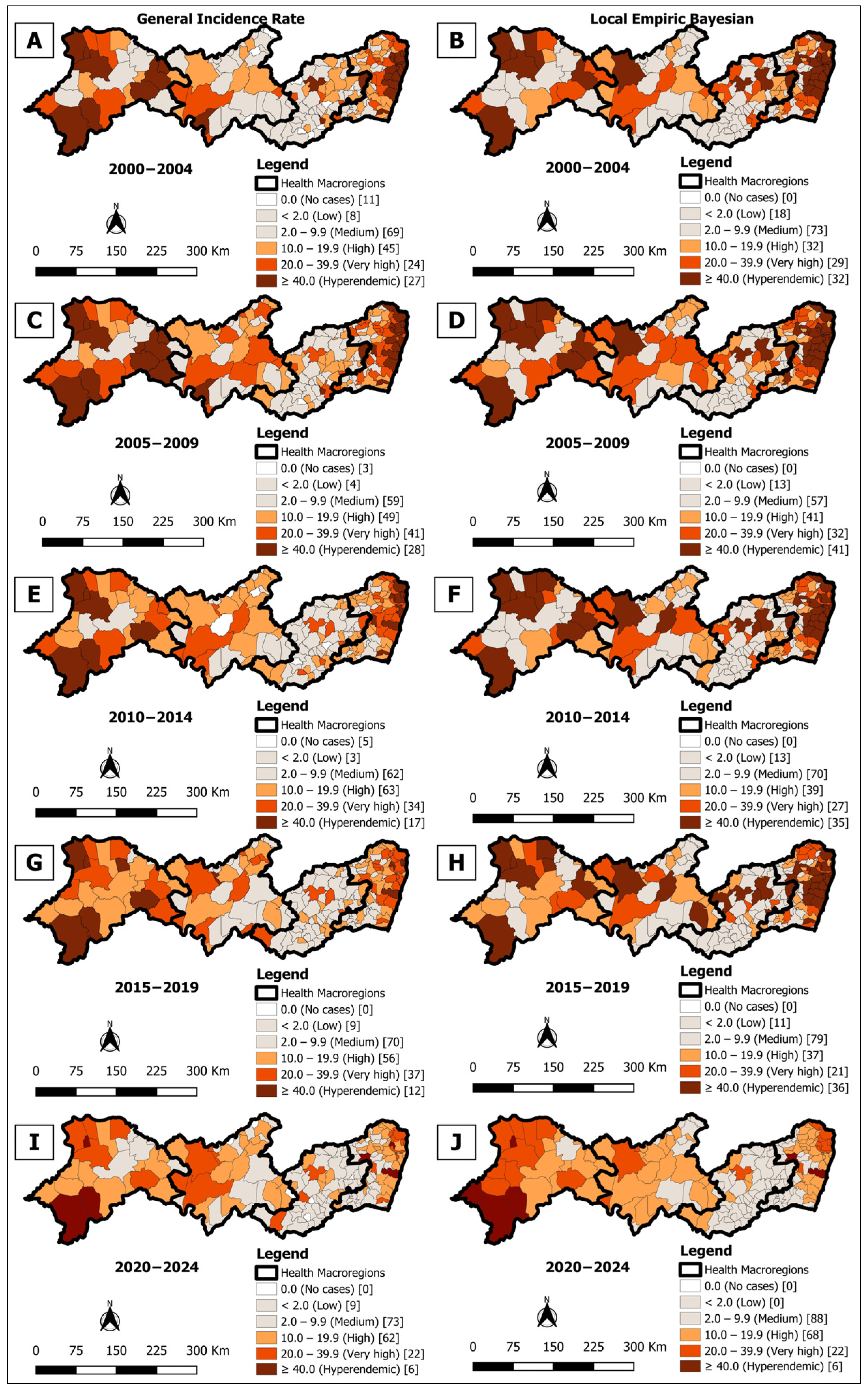
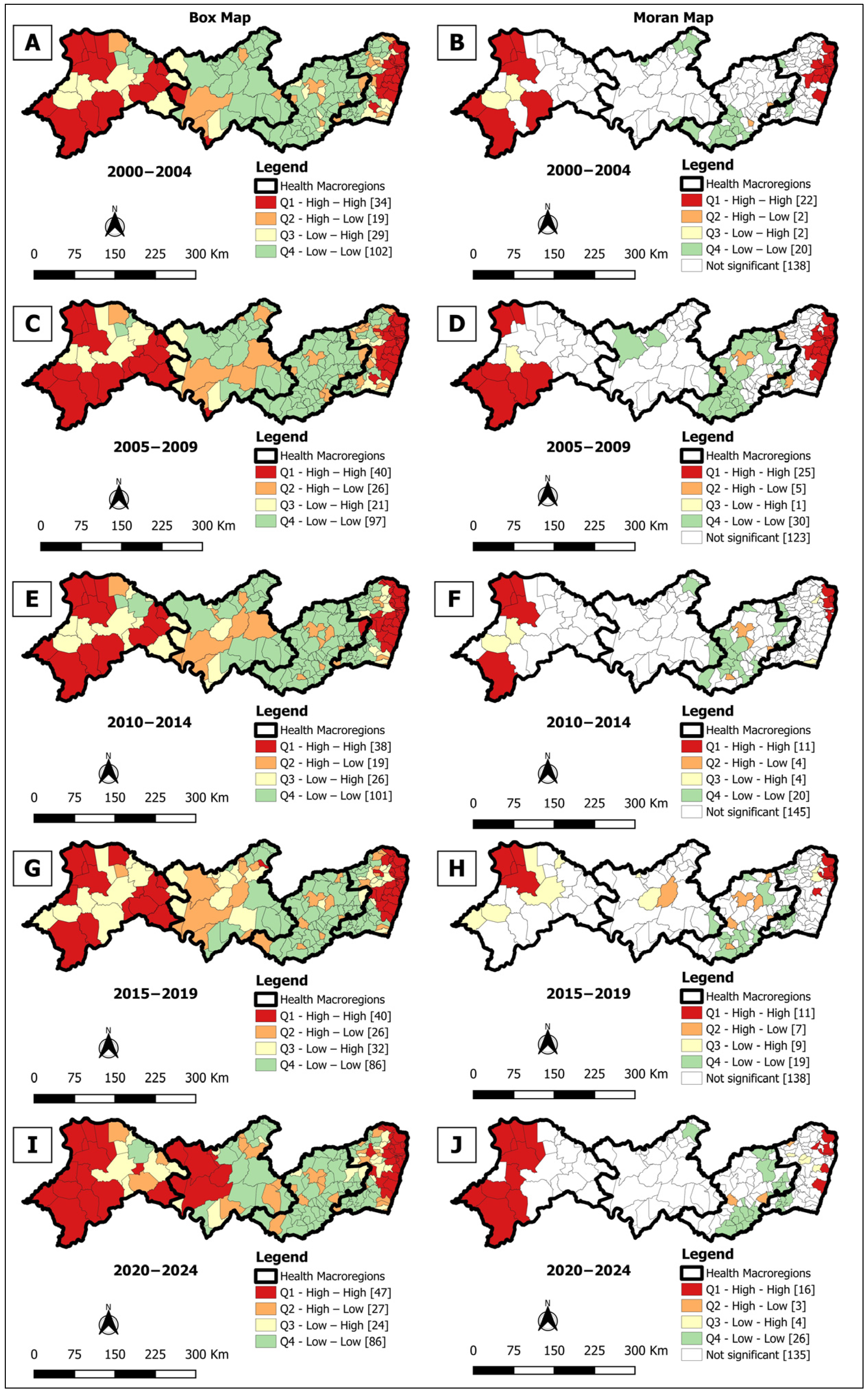

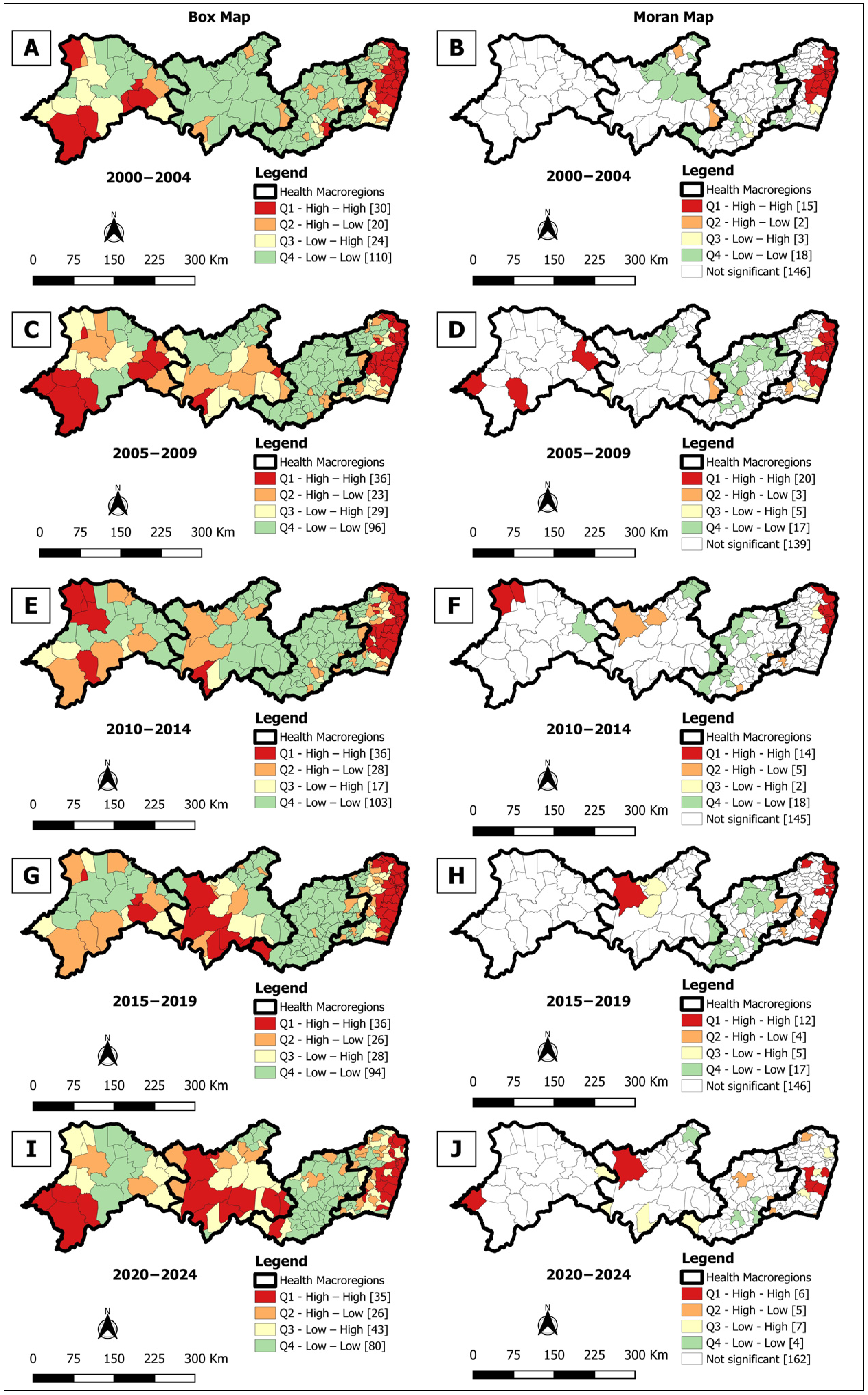
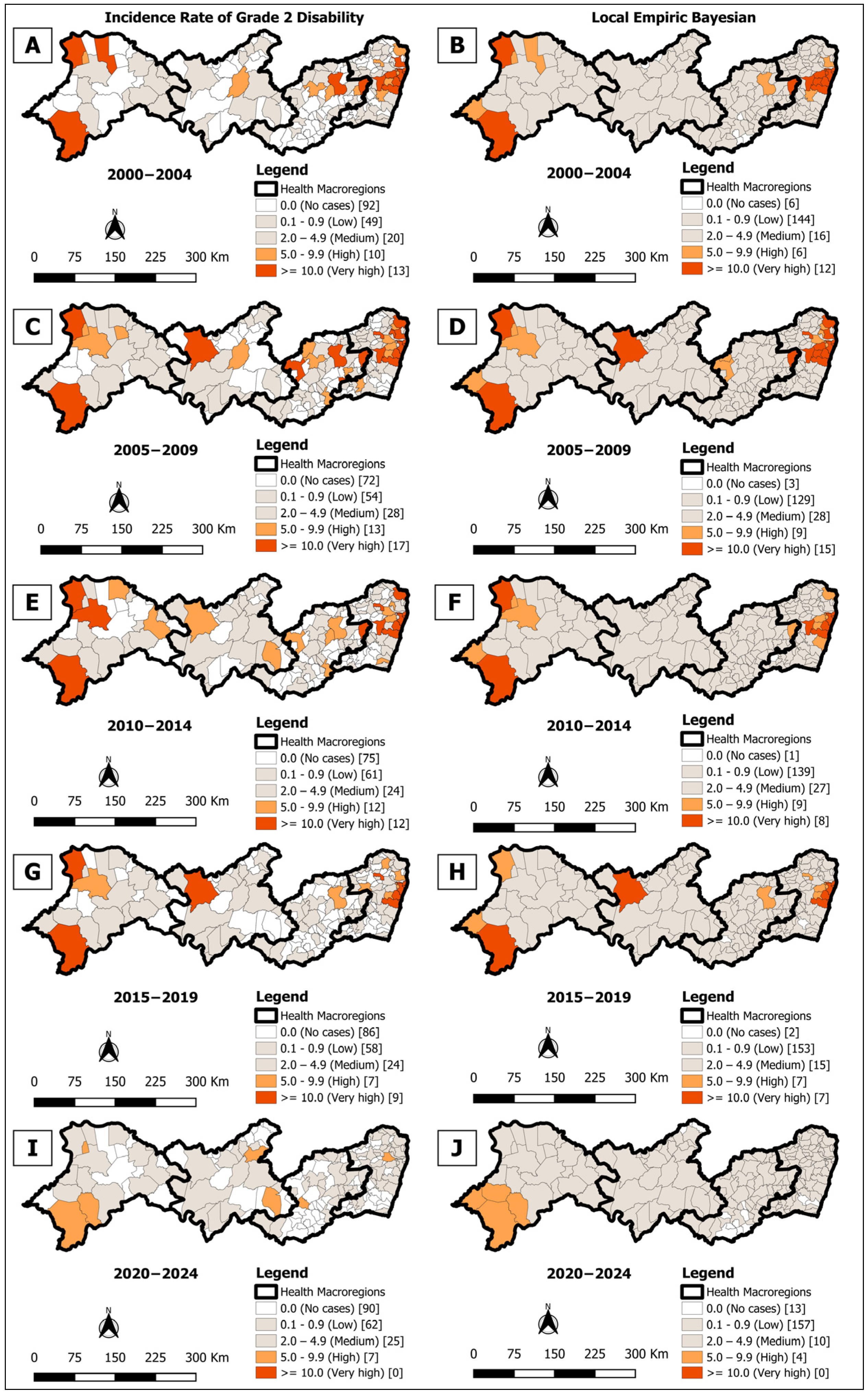
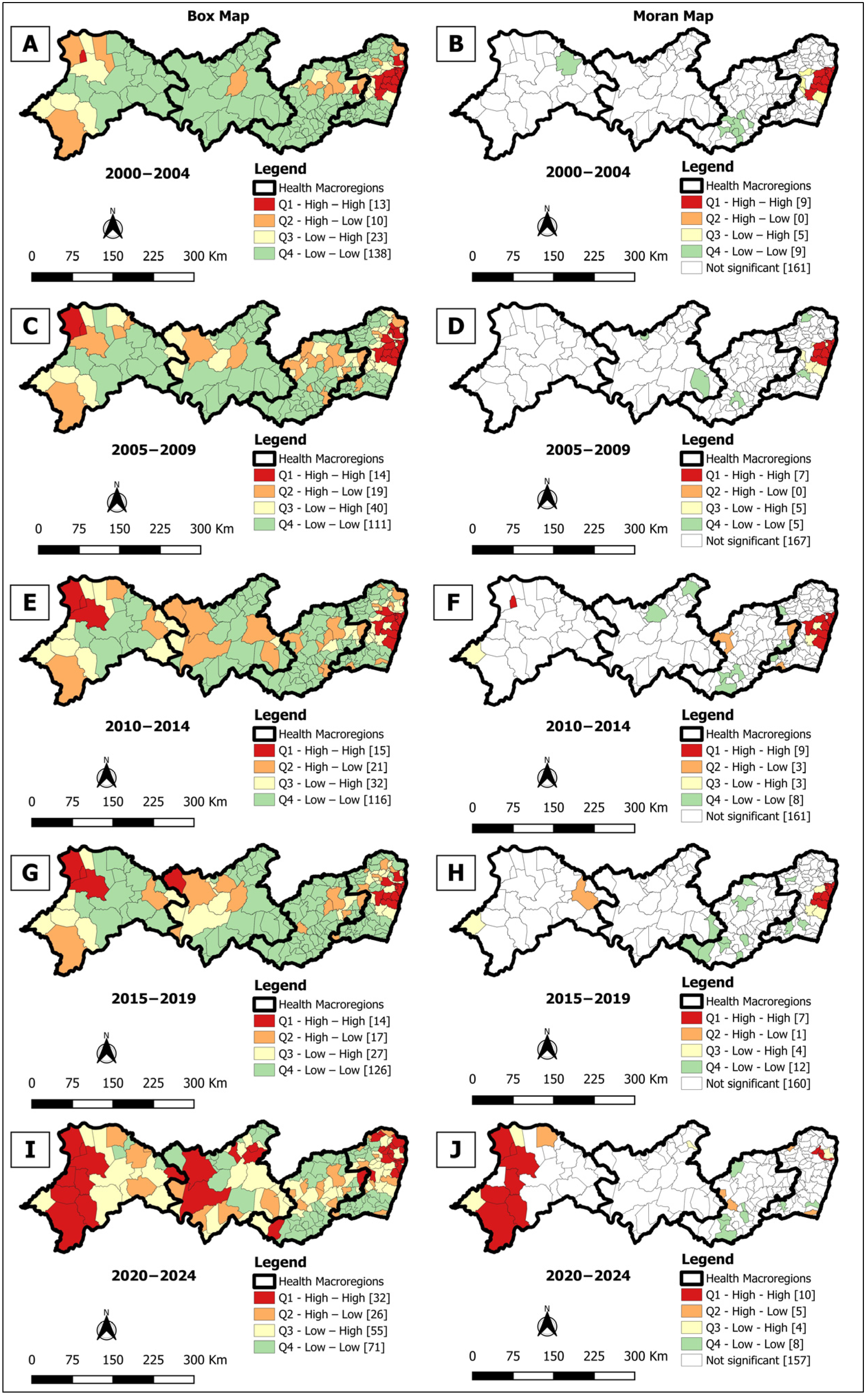
| Sociodemographic and Economic Variables | Pernambuco | Health Macro-Regions | |||
|---|---|---|---|---|---|
| I | II | III | IV | ||
| Total population (inhabitants) | 9,557,070 | 5,771,869 | 1,922,110 | 855,144 | 1,007,947 |
| Territorial area (Km2) | 98,068 | 13,607.7 | 18,578.3 | 30,262.6 | 35,619.5 |
| Demographic density (hab./Km2) | 97.5 | 424.2 | 103.5 | 28.3 | 28.3 |
| % Households with water supply (general water supply network) | 76.0 | 80.1 | 70.7 | 59.9 | 73.0 |
| % Households by sanitary installation (rainwater network) | 43.7 | 38.8 | 56.1 | 44.5 | 47.5 |
| % Households by type of waste disposal (Collected) | 81.6 | 88.3 | 77.3 | 58.5 | 67.3 |
| GDP per capita (R$) | 19,164.50 | 15,852.30 | 10,387.40 | 9258.60 | 9382.70 |
| GDP Current values (R$) (Million) | 181,550,642.01 | 135,260,101.18 | 24,890,956.66 | 8,989,749.64 | 12,409,834.54 |
| Life expectancy at birth | 71.1 | 70.9 | 69.7 | 69.9 | 70.6 |
| Human Development Index (HDI) (average) | 0.673 | 0.614 | 0.574 | 0.593 | 0.598 |
| % Literacy | 83.3 | 77.3 | 71.4 | 75.3 | 77.4 |
| Population National Health System (SUS) dependent (inhabitants) | 8,168,411 | 4,495,281 | 1,788,020 | 831,992 | 1,053,214 |
| % population SUS-dependent | 86.0 | 80.5 | 93.7 | 97.9 | 91.2 |
| % Population coverage estimated by the Community Health Agent Teams | 84.6 | 94.9 | 93.7 | 98.6 | 98.6 |
| % Estimated population coverage by Health Teams | 80.6 | 92.4 | 96.2 | 94.6 | 90.6 |
| Indicator | Calculation Method | Usefulness | Parameters |
|---|---|---|---|
| Average annual incidence of leprosy per 100,000 inhabitants | Numerator: new cases resident in a given location per five-year period. Divided by 5. Denominator: resident population of the middle year of each five-year period in the same location. Multiplication factor: 100,000 | To measure morbidity strength, magnitude, and endemic trend. | Hyperendemic: ≥ 40.0/100,000 inhabitants Very high: 20.0 to 39.9/100,000 inhabitants High: 10.0 to 19.9/100,000 inhabitants Medium: 2.0 to 9.9/100,000 inhabitants Low: <2.0/100,000 inhabitants |
| Average annual incidence of leprosy among individuals aged zero to 14 years per 100,000 inhabitants | Numerator: new cases in children under 15 years of age, resident in a given location per five-year period. Divided by 5. Denominator: resident population aged 0 to 14 of the middle year of each five-year period in the same place. Multiplication factor: 100,000 | To measure the strength of recent transmission of the endemic disease and its trend. | Hyperendemic: ≥ 10.0/100,000 inhabitants Very high: 5.0 to 9.9/100,000 inhabitants High: 2.5 to 4.9/100,000 inhabitants Medium: 0.5 to 2.5/100,000 inhabitants. Low: <0.5/100,000 inhabitants |
| Average rate of incidence of grade 2 physical disability at the time of diagnosis per 100,000 inhabitants | Numerator: new cases with grade 2 physical disability at diagnosis, resident in a given location per five-year period. Divided by 5. Denominator: resident population of the middle year of each five-year period in the same place. Multiplication factor: 100,000 | To evaluate deformities caused by leprosy in the general population and the monitoring of the trend of timely detection of new cases. | Very high: ≥10.0/100,000 inhabitants. High: 5.0 to 9.9/100,000 inhabitants. Medium: 2.0 to 4.9/100,000 inhabitants. Low: 0.1 to 1.9/100,000 inhabitants. |
| Five-Year Period | Overall Detection Rate | Detection Rate in Children Under 15 Years of Age | Detection Rate with Grade 2 Physical Disability at the Time of Diagnosis | |||
|---|---|---|---|---|---|---|
| Moran’s I | p Value | Moran’s I | p Value | Moran’s I | p Value | |
| 2000–2004 | 0.3 | 0.01 | 0.2 | 0.01 | 0.4 | 0.01 |
| 2005–2009 | 0.4 | 0.01 | 0.3 | 0.01 | 0.3 | 0.01 |
| 2010–2014 | 0.3 | 0.01 | 0.4 | 0.01 | 0.3 | 0.01 |
| 2015–2019 | 0.3 | 0.01 | 0.1 | 0.01 | 0.3 | 0.01 |
| 2020–2024 | 0.3 | 0.00 | 0.0 | 0.04 | 0.1 | 0.00 |
Disclaimer/Publisher’s Note: The statements, opinions and data contained in all publications are solely those of the individual author(s) and contributor(s) and not of MDPI and/or the editor(s). MDPI and/or the editor(s) disclaim responsibility for any injury to people or property resulting from any ideas, methods, instructions or products referred to in the content. |
© 2025 by the authors. Licensee MDPI, Basel, Switzerland. This article is an open access article distributed under the terms and conditions of the Creative Commons Attribution (CC BY) license (https://creativecommons.org/licenses/by/4.0/).
Share and Cite
Barbosa, C.C.; Bezerra, G.S.N.; Xavier, A.T.; Oliveira, A.L.S.d.; Medeiros, M.S.d.; Bonfim, C.V.d.; Medeiros, Z.M.d.; Souza, W.V.d. Analysis of the Spatial Distribution of New Cases of Leprosy in the State of Pernambuco, Northeast Brazil. Trop. Med. Infect. Dis. 2025, 10, 327. https://doi.org/10.3390/tropicalmed10120327
Barbosa CC, Bezerra GSN, Xavier AT, Oliveira ALSd, Medeiros MSd, Bonfim CVd, Medeiros ZMd, Souza WVd. Analysis of the Spatial Distribution of New Cases of Leprosy in the State of Pernambuco, Northeast Brazil. Tropical Medicine and Infectious Disease. 2025; 10(12):327. https://doi.org/10.3390/tropicalmed10120327
Chicago/Turabian StyleBarbosa, Celivane Cavalcanti, Gilberto Silva Nunes Bezerra, Amanda Tavares Xavier, André Luiz Sá de Oliveira, Marcílio Sandro de Medeiros, Cristine Vieira do Bonfim, Zulma Maria de Medeiros, and Wayner Vieira de Souza. 2025. "Analysis of the Spatial Distribution of New Cases of Leprosy in the State of Pernambuco, Northeast Brazil" Tropical Medicine and Infectious Disease 10, no. 12: 327. https://doi.org/10.3390/tropicalmed10120327
APA StyleBarbosa, C. C., Bezerra, G. S. N., Xavier, A. T., Oliveira, A. L. S. d., Medeiros, M. S. d., Bonfim, C. V. d., Medeiros, Z. M. d., & Souza, W. V. d. (2025). Analysis of the Spatial Distribution of New Cases of Leprosy in the State of Pernambuco, Northeast Brazil. Tropical Medicine and Infectious Disease, 10(12), 327. https://doi.org/10.3390/tropicalmed10120327







